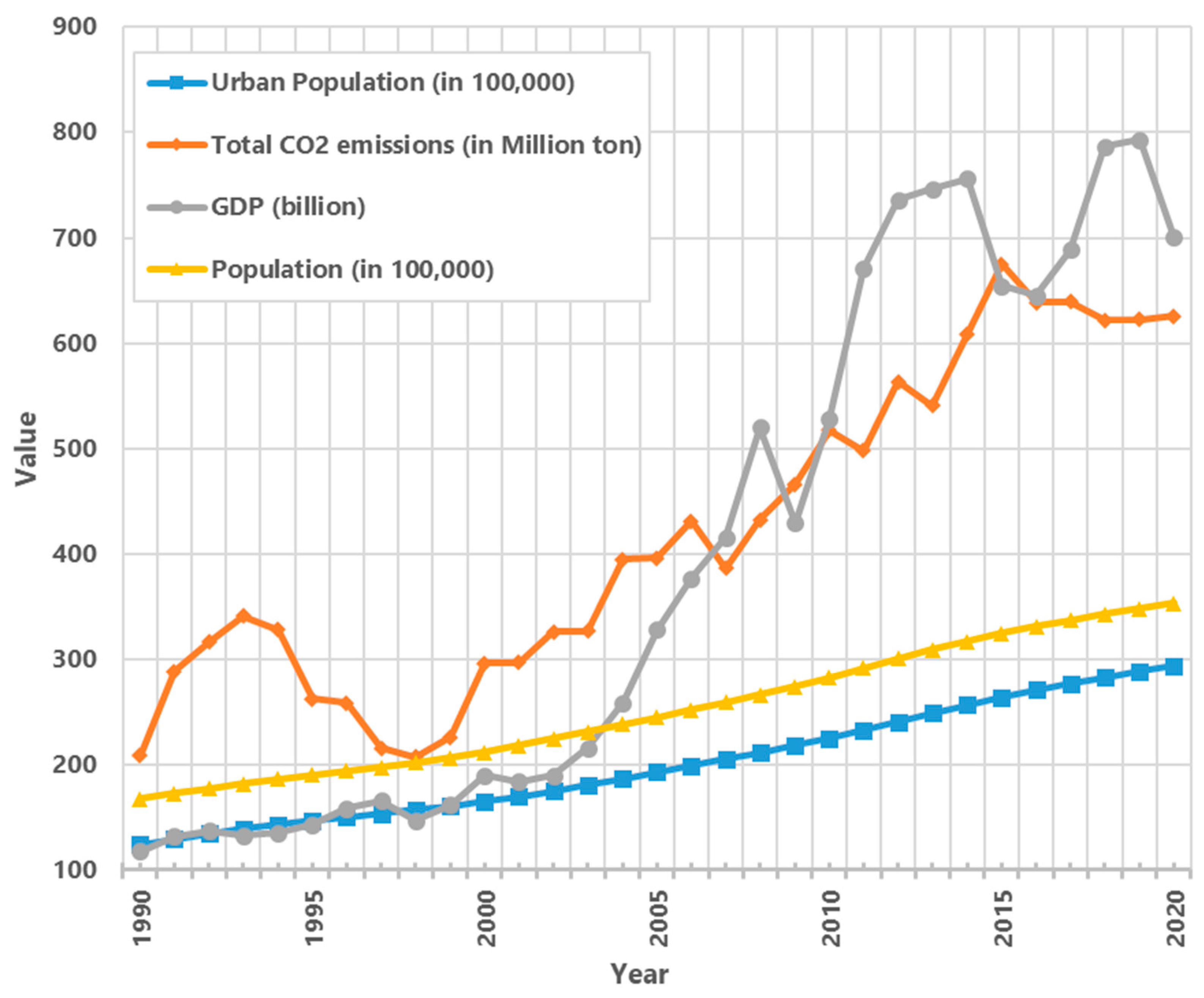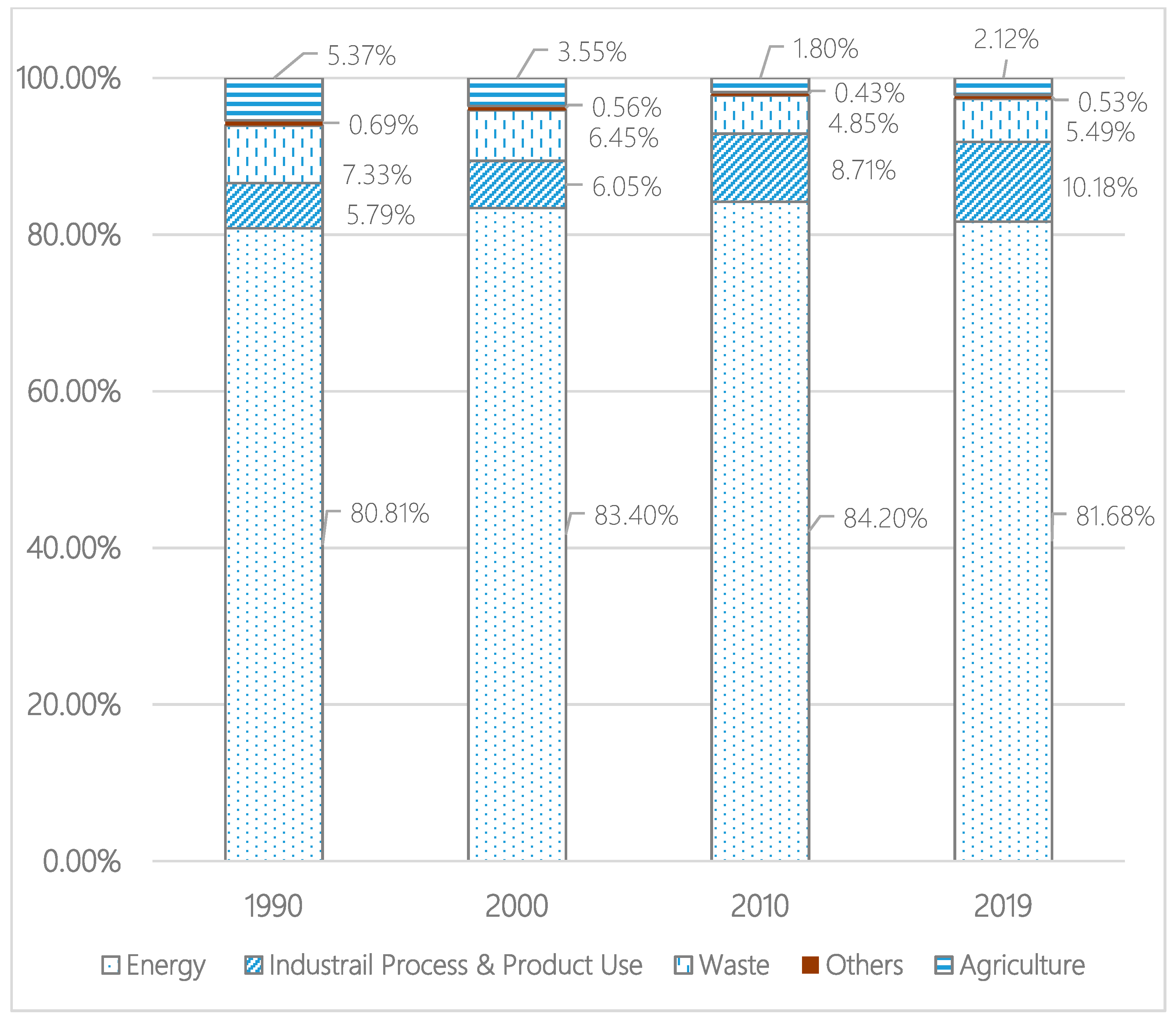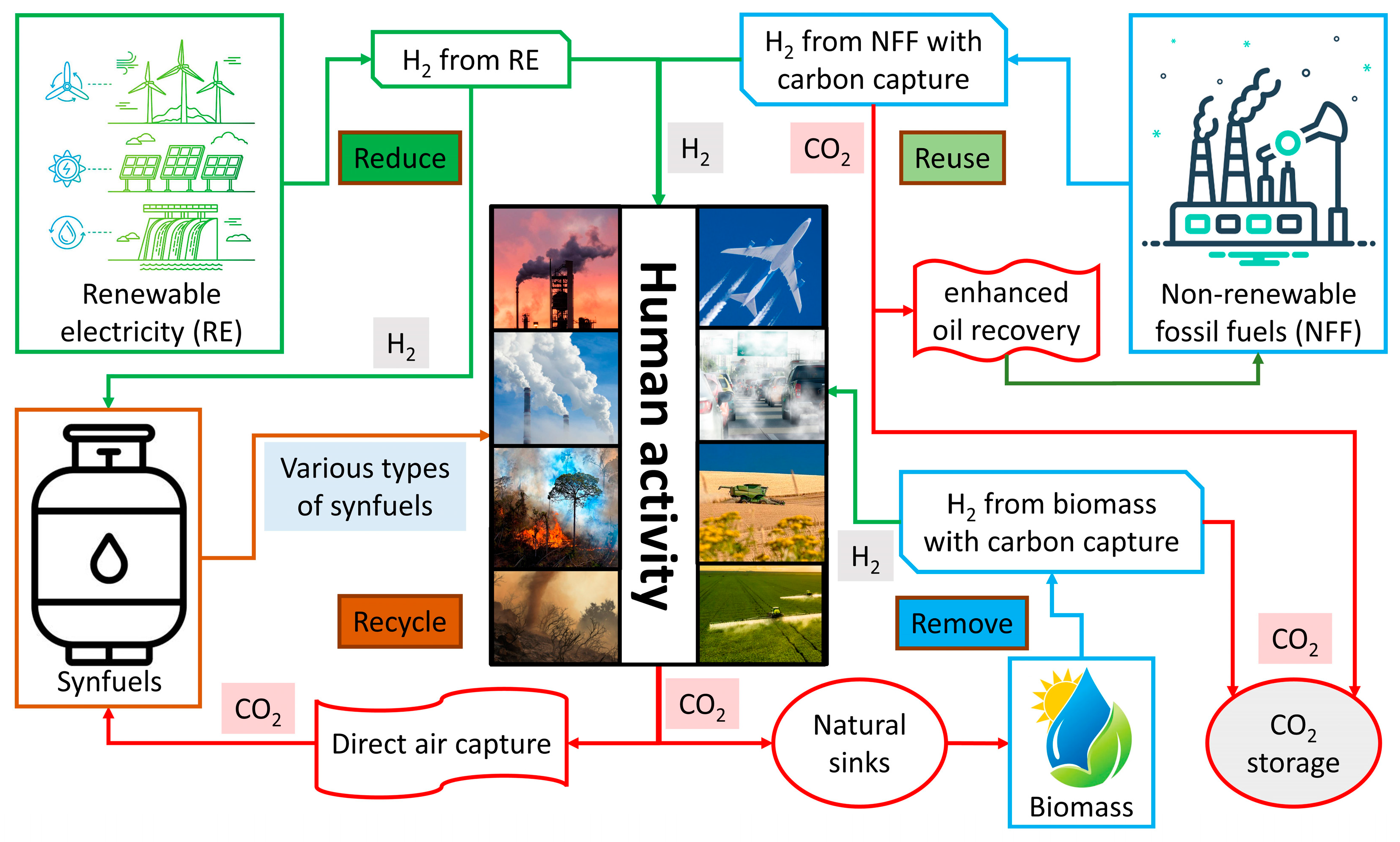Greenhouse Gas Emission Dynamics of Saudi Arabia: Potential of Hydrogen Fuel for Emission Footprint Reduction
Abstract
1. Introduction
2. Historical Greenhouse Gas Emission Trends
2.1. Major Driving Forces of GHG Emission
2.2. Sectorial Emissions
3. Role of Hydrogen in GHG Emissions Reduction
3.1. Uniqueness of Hydrogen
- ✓
- The hydrogen can be kept under higher pressure or as a liquid at extremely low temperatures to boost the volumetric energy density.
- ✓
- It has an effective energy content per weight (almost three times that of gasoline), but at typical temperatures and pressure, the energy density per volume is relatively low.
- ✓
- Due to excellent flammability, hydrogen may be ignited and burned with little energy.
- ✓
- Hydrogen combustion releases no sulfur, carbon dioxide (CO2), or particle pollutants. Thus, it supports sustainable development.
- ✓
- Renewable resources can be used to make hydrogen by electrolyzing water generally fed to the gas network to bypass the constrained electricity systems.
3.2. Use of Hydrogen
3.3. Hydrogen Value Chain
3.4. Applications of Hydrogen in Saudi Arabia for GHG Emission Reduction
4. Conclusions
Author Contributions
Funding
Institutional Review Board Statement
Informed Consent Statement
Acknowledgments
Conflicts of Interest
References
- E.U. Information Adminstration—Department of Energy. Annual Energy Review 2011—Released September 2012. 2011. Available online: https://www.eia.gov/totalenergy/data/annual/pdf/aer.pdf (accessed on 1 August 2022).
- Shafiullah, M.; Ahmed, S.D.; Al-Sulaiman, F.A. Grid Integration Challenges and Solution Strategies for Solar PV Systems: A Review. IEEE Access 2022, 10, 52233–52257. [Google Scholar] [CrossRef]
- Ahmed, S.D.; Al-Ismail, F.S.M.; Shafiullah, M.; Al-Sulaiman, F.A.; El-Amin, I.M. Grid Integration Challenges of Wind Energy: A Review. IEEE Access 2020, 8, 10857–10878. [Google Scholar] [CrossRef]
- Lynch, M.C. Causes of Oil Price Volatility on JSTOR. JSTOR J. 2002, 28, 107–141. [Google Scholar]
- Chart of the Day: These Countries Create Most of the World’s CO2 Emissions|World Economic Forum. Available online: https://www.weforum.org/agenda/2019/06/chart-of-the-day-these-countries-create-most-of-the-world-s-co2-emissions/ (accessed on 5 June 2022).
- The Climate Transparency Report 2021|Climate Transparency. Available online: https://www.climate-transparency.org/g20-climate-performance/g20report2021 (accessed on 5 June 2022).
- Rahman, S.M.; Al-Ismail, F.S.M.; Haque, M.E.; Shafiullah, M.; Islam, M.R.; Chowdhury, M.T.; Alam, M.S.; Razzak, S.A.; Ali, A.; Khan, Z.A. Electricity generation in Saudi Arabia: Tracing opportunities and challenges to reducing greenhouse gas emissions. IEEE Access 2021, 9, 116163–116182. [Google Scholar] [CrossRef]
- Samargandi, N. Sector value addition, technology and CO2 emissions in Saudi Arabia. Renew. Sustain. Energy Rev. 2017, 78, 868–877. [Google Scholar] [CrossRef]
- Rahman, S.M.; Khondaker, A.N. Mitigation measures to reduce greenhouse gas emissions and enhance carbon capture and storage in Saudi Arabia. Renew. Sustain. Energy Rev. 2012, 16, 2446–2460. [Google Scholar] [CrossRef]
- Rahman, S.M.; Khondaker, A.N.; Hasan, M.A.; Reza, I. Greenhouse gas emissions from road transportation in Saudi Arabia—A challenging frontier. Renew. Sustain. Energy Rev. 2017, 69, 812–821. [Google Scholar] [CrossRef]
- Liu, H.; Tellez, B.G.; Atallah, T.; Barghouty, M. The role of CO2 capture and storage in Saudi Arabia’s energy future. Int. J. Greenh. Gas Control 2012, 11, 163–171. [Google Scholar] [CrossRef]
- Derwent, R.; Simmonds, P. Global Environmental Impacts of the Hydrogen Economy. Int. J. Nucl. Hydrog. Prod. Appl. 2006, 1, 57–67. [Google Scholar] [CrossRef]
- Alternative Fuels Data Center: Hydrogen Benefits and Considerations. Available online: https://afdc.energy.gov/fuels/hydrogen_benefits.html (accessed on 29 August 2022).
- Scheller, F.; Wald, S.; Kondziella, H.; Gunkel, P.A.; Bruckner, T.; Keles, D. Future role and economic benefits of hydrogen and synthetic energy carriers in Germany: A review of long-term energy scenarios. Sustain. Energy Technol. Assess. 2023, 56, 103037. [Google Scholar] [CrossRef]
- Tawfik, A.; Moanis, R.; Qyyum, M.A.; Kumari, S.; Bux, F.; Ayub, H.M.U.; Khan, M.S.; Bokhari, A.; Mubashir, M.; Khoo, K.S.; et al. Sustainable fermentation approach for biogenic hydrogen productivity from delignified sugarcane bagasse. Int. J. Hydrog. Energy 2022, 47, 37343–37358. [Google Scholar] [CrossRef]
- Tawfik, A.; Tan, X.; Elsamadony, M.; Qyyum, M.A.; Azzam, A.M.; Mubashir, M.; Ng, H.S.; Akhtar, M.S.; Khoo, K.S. Graphene/hydroxyapatite nano-composite for enhancement of hydrogen productivity from delignified duckweed. Fuel 2022, 330, 125537. [Google Scholar] [CrossRef]
- US Hydrogen Road Map—Fuel Cell & Hydrogen Energy Association. Available online: https://www.fchea.org/us-hydrogen-study (accessed on 29 August 2022).
- Factsheet on China, the World’s Largest Hydrogen Producer and Consumer—PtX Hub. Available online: https://ptx-hub.org/factsheet-on-china-the-worlds-largest-hydrogen-producer-and-consumer/ (accessed on 29 August 2022).
- Accelerating Green Hydrogen Technologies and Energy Storage for The Energy Transition|G20 Side Events: Recover Together Recover Stronger. Available online: https://g20sideevents.id/news/photo/202/accelerating-green-hydrogen-technologies-and-energy-storage-for-the-energy-transition.html (accessed on 29 August 2022).
- Raman, R.; Nair, V.K.; Prakash, V.; Patwardhan, A.; Nedungadi, P. Green-hydrogen research: What have we achieved, and where are we going? Bibliometrics analysis. Energy Rep. 2022, 8, 9242–9260. [Google Scholar] [CrossRef]
- Climate Change 2022: Mitigation of Climate Change. Available online: https://www.ipcc.ch/report/ar6/wg3/ (accessed on 18 October 2022).
- Abdin, Z.; Zafaranloo, A.; Rafiee, A.; Mérida, W.; Lipiński, W.; Khalilpour, K.R. Hydrogen as an energy vector. Renew. Sustain. Energy Rev. 2020, 120, 109620. [Google Scholar] [CrossRef]
- Brändle, G.; Schönfisch, M.; Schulte, S. Estimating long-term global supply costs for low-carbon hydrogen. Appl. Energy 2021, 302, 117481. [Google Scholar] [CrossRef]
- Davis, S.J.; Lewis, N.S.; Shaner, M.; Aggarwal, S.; Arent, D.; Azevedo, I.L.; Benson, S.M.; Bradley, T.; Brouwer, J.; Chiang, Y.-M.; et al. Net-zero emissions energy systems. Science 2018, 360, 6396. [Google Scholar] [CrossRef] [PubMed]
- DeAngelo, J.; Azevedo, I.; Bistline, J.; Clarke, L.; Luderer, G.; Byers, E.; Davis, S.J. Energy systems in scenarios at net-zero CO2 emissions. Nat. Commun. 2021, 121, 6096. [Google Scholar] [CrossRef]
- Pye, S.; Broad, O.; Bataille, C.; Brockway, P.; Daly, H.E.; Freeman, R.; Gambhir, A.; Geden, O.; Rogan, F.; Sanghvi, S.; et al. Modelling net-zero emissions energy systems requires a change in approach. Clim. Policy 2020, 21, 222–231. [Google Scholar] [CrossRef]
- El Mrabet, R.; Berrada, A. Hydrogen production and derivatives from renewable energy systems for a best valorization of sustainable resources. Hybrid Energy Syst. Model. 2021, 2021, 343–363. [Google Scholar] [CrossRef]
- Tarhan, C.; Çil, M.A. A study on hydrogen, the clean energy of the future: Hydrogen storage methods. J. Energy Storage 2021, 40, 102676. [Google Scholar] [CrossRef]
- Aljarallah, R.A. An assessment of the economic impact of natural resource rents in kingdom of Saudi Arabia. Resour. Policy 2021, 72, 102070. [Google Scholar] [CrossRef]
- Yusuf, N.; Shesha, L.S. Economic Role of Population Density during Pandemics—A Comparative Analysis of Saudi Arabia and China. Int. J. Environ. Res. Public Health 2021, 18, 4318. [Google Scholar] [CrossRef] [PubMed]
- The World Bank. Population, Total|Data; The World Bank: Washington, DC, USA, 2020. [Google Scholar]
- Friedlingstein, P.; O’sullivan, M.; Jones, M.W.; Andrew, R.M.; Hauck, J.; Olsen, A.; Peters, G.P.; Peters, W.; Pongratz, J.; Sitch, S.; et al. Global Carbon Budget 2020. Earth Syst. Sci. Data 2020, 12, 3269–3340. [Google Scholar] [CrossRef]
- Andrew, R.M.; Peters, G.P. The Global Carbon Project’s Fossil CO2 Emissions Dataset; Zenodo: Geneva, Switzerland, 2021. [Google Scholar]
- United Nations/DESA. World Urbanization Prospects—Population Division; United Nations: New York, NY, USA, 2019.
- Ritchie, H. Sector by sector: Where do global greenhouse gas emissions come from?—Our World in Data. Our World Data. 2020. Available online: https://ourworldindata.org/ghg-emissions-by-sector (accessed on 19 March 2023).
- Friedlingstein, P.; Jones, M.W.; O’Sullivan, M.; Andrew, R.M.; Bakker, D.C.; Hauck, J.; Le, Q.C.; Peter, G.P.; Peters, W.; Pongratz, J.; et al. Global Carbon Budget 2021. Earth Syst. Sci. Data 2022, 14, 1917–2005. [Google Scholar] [CrossRef]
- Bazoobandi, S. Old Fund, New Mandate: Saudi Arabia’s Public Investment Fund (PIF). Int. Polit. Econ. Ser. 2021, 207–231. [Google Scholar] [CrossRef]
- Khondaker, A.N.; Rahman, S.M.; Malik, K.; Hossain, N.; Razzak, S.A.; Khan, R.A. Dynamics of energy sector and GHG emissions in Saudi Arabia. Clim. Policy 2014, 15, 517–541. [Google Scholar] [CrossRef]
- Krane, J.; Wilson, W.S. Energy Governance in Saudi Arabia: An Assessment of the Kingdom’s Resources, Policies, and Climate Approach; Rice University’s Baker Institute for Public Policy: Houston, TX, USA, 2019. [Google Scholar]
- Rahman, S.M.; Khondaker, A.N.; Hossain, M.I.; Shafiullah, M.; Hasan, M.A. Neurogenetic modeling of energy demand in the United Arab Emirates, Saudi Arabia, and Qatar. Environ. Prog. Sustain. Energy 2017, 36, 1208–1216. [Google Scholar] [CrossRef]
- International Energy Agency. Energy and Carbon Tracker Users Guide 2020 Edition Energy and Carbon Tracker Users Guide How to Use This Product; International Energy Agency: Paris, France, 2019.
- Gütschow, J.; Jeffery, M.L.; Gieseke, R.; Gebel, R.; Stevens, D.; Krapp, M.; Rocha, M. The PRIMAP-hist national historical emissions time series. Earth Syst. Sci. Data 2016, 8, 571–603. [Google Scholar] [CrossRef]
- Ministry of Energy Industry and Mineral Resources. Third National Communication of the Kingdom of Saudi Arabia; Ministry of Energy Industry and Mineral Resources: Riyadh, Saudi Arabia, 2016; pp. 173–174.
- Selimuzzaman, S.M. Present and Future Solid Waste Management Practices in Saudi Arabia to combat Greenhouse Gas Emissions. In Proceedings of the 12th International Conference on Computational Science and Its Applications, Bahia, Brazil, 18–21 June 2012; pp. 1–13. [Google Scholar]
- De Miranda, P.E.V. Science and Engineering of Hydrogen-Based Energy Technologies: Hydrogen Production and Practical Applications in Energy Generation; Academic Press: Cambridge, MA, USA, 2019; pp. 1–38. [Google Scholar]
- Hydrogen Properties|Connecticut Hydrogen-Fuel Cell Coalition. Available online: https://chfcc.org/hydrogen-fuel-cells/about-hydrogen/hydrogen-properties/ (accessed on 2 August 2022).
- Global EV Outlook 2020—Analysis—IEA. Available online: https://www.iea.org/reports/global-ev-outlook-2020 (accessed on 14 March 2023).
- Hydrogen Production and Delivery|Hydrogen and Fuel Cells|Hydrogen and Fuel Cells|NREL. Available online: https://www.nrel.gov/hydrogen/hydrogen-production-delivery.html (accessed on 14 March 2023).
- Pan, G.; Bai, Y.; Song, H.; Qu, Y.; Wang, Y.; Wang, X. Hydrogen Fuel Cell Power System— Development Perspectives for Hybrid Topologies. Energies 2023, 16, 2680. [Google Scholar] [CrossRef]
- The Future of Hydrogen—Analysis—IEA. Available online: https://www.iea.org/reports/the-future-of-hydrogen (accessed on 14 March 2023).
- Belikov, J.; Błoński, K.; Mańkowska, M.; Rzeczycki, A. Research on the Concept of Hydrogen Supply Chains and Power Grids Powered by Renewable Energy Sources: A Scoping Review with the Use of Text Mining. Energies 2022, 15, 866. [Google Scholar] [CrossRef]
- Northeastern Brazil to Build World’s Biggest Green Hydrogen Plant|Wilson Center. Available online: https://www.wilsoncenter.org/blog-post/northeastern-brazil-build-worlds-biggest-green-hydrogen-plant (accessed on 2 August 2022).
- Hydrogen Projects in the US—Clean Energy Group. Available online: https://www.cleanegroup.org/ceg-projects/hydrogen/projects-in-the-us/ (accessed on 2 August 2022).
- China Sets Green Hydrogen Target for 2025, Eyes Widespread Use|Reuters. Available online: https://www.reuters.com/world/china/china-produce-100000-200000-t-green-hydrogen-annually-by-2025-2022-03-23/ (accessed on 2 August 2022).
- Hassan, Q.; Abdulateef, A.M.; Hafedh, S.A.; Al-samari, A.; Abdulateef, J.; Sameen, A.Z.; Salman, H.M.; Al-Jiboory, A.K.; Wieteska, S.; Jaszczur, M. Renewable energy-to-green hydrogen: A review of main resources routes, processes and evaluation. Int. J. Hydrog. Energy 2023. [Google Scholar] [CrossRef]
- Alam, M.S.; Al-Ismail, F.S.; Salem, A.; Abido, M.A. High-Level Penetration of Renewable Energy Sources into Grid Utility: Challenges and Solutions. IEEE Access 2020, 8, 190277–190299. [Google Scholar] [CrossRef]
- Banihabib, R.; Assadi, M. A Hydrogen-Fueled Micro Gas Turbine Unit for Carbon-Free Heat and Power Generation. Sustainability 2022, 14, 13305. [Google Scholar] [CrossRef]
- Shafiullah, M.; Refat, A.M.; Haque, M.E.; Chowdhury, D.M.H.; Hossain, M.S.; Alharbi, A.G.; Alam, M.S.; Ali, A.; Hossain, S. Review of Recent Developments in Microgrid Energy Management Strategies. Sustainability 2022, 14, 14794. [Google Scholar] [CrossRef]
- Ozalp, N. Energy and material flow models of hydrogen production in the U.S. Chemical Industry. Int. J. Hydrog. Energy 2008, 33, 5020–5034. [Google Scholar] [CrossRef]
- Tashie-Lewis, B.C.; Nnabuife, S.G. Hydrogen Production, Distribution, Storage and Power Conversion in a Hydrogen Economy—A Technology Review. Chem. Eng. J. Adv. 2021, 8, 100172. [Google Scholar] [CrossRef]
- Mohideen, M.M.; Subramanian, B.; Sun, J.; Ge, J.; Guo, H.; Radhamani, A.V.; Ramakrishna, S.; Liu, Y. Techno-economic analysis of different shades of renewable and non-renewable energy-based hydrogen for fuel cell electric vehicles. Renew. Sustain. Energy Rev. 2023, 174, 113153. [Google Scholar] [CrossRef]
- Javaid, M.S.; Irshad, U.B.; Abido, M.A.; Khalid, Z.; Alam, M.S.; Rana, M.J. Direct control of three-phase smart load for neutral current mitigation. In Proceedings of the 2016 19th International Multi-Topic Conference INMIC, Kolkata, India, 5–6 December 2017. [Google Scholar] [CrossRef]
- The Hydrogen Value Chain from Production to Applications. Available online: https://energy.danube-region.eu/wp-content/uploads/sites/6/sites/6/2019/12/Matthias_Schl%C3%A9gel_FICHTNER-Hydrogen-Value-Chain.pdf (accessed on 5 August 2022).
- Reducing Emissions—Saudi Green Initiative. Available online: https://www.saudigreeninitiative.org/targets/reducing-emissions/ (accessed on 2 August 2022).
- Net Zero by 2050—Analysis—IEA. Available online: https://www.iea.org/reports/net-zero-by-2050 (accessed on 2 August 2022).
- Hydrogen: A Clean, Flexible Energy Carrier|Department of Energy. Available online: https://www.energy.gov/eere/articles/hydrogen-clean-flexible-energy-carrier (accessed on 2 August 2022).
- Park, C.; Koo, M.; Woo, J.R.; Hong, B.I.; Shin, J. Economic valuation of green hydrogen charging compared to gray hydrogen charging: The case of South Korea. Int. J. Hydrog. Energy 2022, 47, 14393–14403. [Google Scholar] [CrossRef]
- Hasan, S.; Shabaneh, R. The Economics and Resource Potential of Hydrogen Production in Saudi Arabia; KAPSARC: Riyadh, Saudi Arabia, 2021. [Google Scholar] [CrossRef]
- Alrashed, F.; Zahid, U. Comparative analysis of conventional steam methane reforming and PdAu membrane reactor for the hydrogen production. Comput. Chem. Eng. 2021, 154, 107497. [Google Scholar] [CrossRef]
- Boretti, A.; Banik, B.K. Advances in Hydrogen Production from Natural Gas Reforming. Adv. Energy Sustain. Res. 2021, 2, 2100097. [Google Scholar] [CrossRef]
- Siemens. Power-to-X: The crucial business on the way to a carbon-free world. Tech. Pap. Siemens AG 2019. Available online: https://www.siemens-energy.com/global/en/offerings/technical-papers/download-power-to-x.html (accessed on 19 March 2023).
- Kurtz, J.M.; Sprik, S.; Saur, G.; Onorato, S. Fuel Cell Electric Vehicle Durability and Fuel Cell Performance; National Renewable Energy Lab: Golden, CO, USA, 2019. [Google Scholar] [CrossRef]
- Jouin, M.; Bressel, M.; Morando, S.; Gouriveau, R.; Hissel, D.; Péra, M.C.; Zerhouni, N.; Jemei, S.; Hilairet, M.; Bouamama, B.O. Estimating the end-of-life of PEM fuel cells: Guidelines and metrics. Appl. Energy 2016, 177, 87–97. [Google Scholar] [CrossRef]
- Knobloch, F.; Pollitt, H.; Chewpreecha, U.; Daioglou, V.; Mercure, J.F. Simulating the deep decarbonisation of residential heating for limiting global warming to 1.5 °C. Energy Effic. 2019, 12, 521–550. [Google Scholar] [CrossRef]
- International Energy Agency. Cross-Cutting: Hydrogen. 2020. Available online: https://www.cceguide.org/wp-content/uploads/2020/08/07-IEA-Cross-cutting.pdf (accessed on 13 October 2022).
- ACWA POWER|NEOM Green Hydrogen Project. Available online: https://acwapower.com/en/projects/neom-green-hydrogen-project/ (accessed on 13 October 2022).




| Value Chain | Applications | Evaluation |
|---|---|---|
| Use of hydrogen as electricity storage | Electric energy sector |
|
| Hydrogen production from excess electric energy | Electric energy and heat sector |
|
| Use of hydrogen as a commodity | Energy, green chemicals, and mobility |
|
Disclaimer/Publisher’s Note: The statements, opinions and data contained in all publications are solely those of the individual author(s) and contributor(s) and not of MDPI and/or the editor(s). MDPI and/or the editor(s) disclaim responsibility for any injury to people or property resulting from any ideas, methods, instructions or products referred to in the content. |
© 2023 by the authors. Licensee MDPI, Basel, Switzerland. This article is an open access article distributed under the terms and conditions of the Creative Commons Attribution (CC BY) license (https://creativecommons.org/licenses/by/4.0/).
Share and Cite
Akinpelu, A.; Alam, M.S.; Shafiullah, M.; Rahman, S.M.; Al-Ismail, F.S. Greenhouse Gas Emission Dynamics of Saudi Arabia: Potential of Hydrogen Fuel for Emission Footprint Reduction. Sustainability 2023, 15, 5639. https://doi.org/10.3390/su15075639
Akinpelu A, Alam MS, Shafiullah M, Rahman SM, Al-Ismail FS. Greenhouse Gas Emission Dynamics of Saudi Arabia: Potential of Hydrogen Fuel for Emission Footprint Reduction. Sustainability. 2023; 15(7):5639. https://doi.org/10.3390/su15075639
Chicago/Turabian StyleAkinpelu, Adeola, Md Shafiul Alam, Md Shafiullah, Syed Masiur Rahman, and Fahad Saleh Al-Ismail. 2023. "Greenhouse Gas Emission Dynamics of Saudi Arabia: Potential of Hydrogen Fuel for Emission Footprint Reduction" Sustainability 15, no. 7: 5639. https://doi.org/10.3390/su15075639
APA StyleAkinpelu, A., Alam, M. S., Shafiullah, M., Rahman, S. M., & Al-Ismail, F. S. (2023). Greenhouse Gas Emission Dynamics of Saudi Arabia: Potential of Hydrogen Fuel for Emission Footprint Reduction. Sustainability, 15(7), 5639. https://doi.org/10.3390/su15075639









